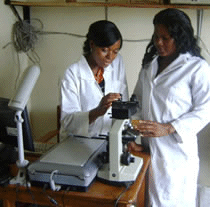
 |
|||||||||||
 |
|||||||||||
|
|||||||||||
|
Sponsored links
|
| Computational Biochemistry for beginners:- |
Review of the essentials of computational Biochemistry; importance and implications. (Page 3)
Forces responsible for the higher orders of protein structures The primary structure of a protein is determined by the covalent linking of each amino acid residues that forms a polypeptide sequence. Unlike the primary structure, the secondary structure and higher orders of protein structure are determined principally by non covalent forces such as hydrogen bonds, ionic bonds, Vanderwaal bonds and hydrophobic interactions. Hydrogen bonding is the kind of interaction that exists when the carbonyl oxygen and the amide hydrogen of the peptide bond in the protein sequence interacts with water molecules in the solvent or with other hydrogen bonding groups in the peptide chain. Hydrophobic interactions is the kind of force that exists between side chains that are not polar, they tends to cluster together in a non polar environment thus reducing the contact they are having with the polar environment. Electrostatic interactions usually exist between charged residues. It is the attractive or repulsive force that exists between opposite and like charges respectively. Proteins usually fold in such a way that charged residues are located in the hydrophobic core of the protein. Salt solutions reduce electrostatic interaction. High concentrations of salt like ammonium sulphate can destabilize and precipitate protein molecules. Vanderwaal force is usually very weak. It occurs as a result of instantaneous dipole –induced dipole interactions which arise because of the fluctuations in the electron charge distribution of an adjacent non bonded atom. Because of the large occurrence of this type of interaction, the overall effect is usually very significant. Secondary structure of protein sequence This structure results from the hydrogen bonding interactions that exists between the members of the amino acid sequence that make up the protein. There are 3 common type of secondary structure; the alpha helix, beta conformation and the beta turns Alpha helix Helical structures are the simplest arrangement that a polypeptide chain could assume with its rigid peptide bond. In this structure, the polypeptide backbone is tightly wound around an imaginary axis drawn longitudinal through the middle of the helix and the side chain of the amino acid protrudes outwards from the helical backbone. The alpha helix optimizes the use of its internal Hydrogen bonds. Its structure is stabilized by a hydrogen bond between the hydrogen attached to the electronegative nitrogen atom of a peptide linkage and the electronegative carbonyl oxygen atom of the fourth amino acid on the amino terminal side of that peptide bond (except those close to each end of the helix) Each successive turn of the alpha helix is held to adjacent turn by 3 to 4 hydrogen bonds. Beta sheet This conformation has a zig-zag like backbone that looks like series of pleats. Here, hydrogen bonds are formed between adjacent segments of polypeptide chain. The segments of amino acid that participate in beta sheet formation may be on the same or different polypeptide chain. Usually the side chain of the adjacent amino acid protrudes from the Zig-Zag beta sheet structure, in opposite direction creating a kind of alternating pattern. Beta turns These secondary structures of protein function to connect successive turns of alpha helix or beta conformation together. The structure is a 180 degree turn involving four amino acid residues, with the carbonyl oxygen of the first residue forming a hydrogen bond with the amino group hydrogen of the fourth. Glycine and Proline are usually found in beta turns. Beta turns are found near the surface of a protein where the peptide groups of the two central amino acid residues in the turn can hydrogen-bond with water. Tertiary structure Tertiary structures are formed from the interactions that exist between the different secondary structures that occur in a particular polypeptide sequence. This structure is stabilized by the weak non covalent forces and also covalent bonding from disulphide linkages in the polypeptide sequence. It gives room for distanced amino acid in the different secondary structure of a polypeptide sequence to come close enough to interact hereby stabilizing the sequence the more. The tertiary structure usually gives rise to a functional three dimensional structure. It encompasses the overall three dimensional arrangement of all atoms in a protein. Each tertiary structure could be referred to as a functional domain or motif. Quaternary structure Quaternary structure occurs when two or more tertiary structure exists and interacts with each other in a polypeptide chain. The different subunits or tertiary structure in the quaternary structure perform distinct functional role. They are stabilized by weak and covalent forces (disulphide) The three dimensional structure of a protein can be deduced using different technique which often include NMR, X-ray etc. The elucidation of the three dimensional configuration of protein usually require that a crystallized form of the protein is obtained. Some proteins readily crystallize on the course of purification, while others require complex manipulations to get them crystallized. The numbers of protein whose three dimensional structure is known today is limited to those protein that has been successively crystallized. Based on the sequences of amino acid that makes up a protein, there is the possibility of predicting its three dimensional structure. Usually the sequence of amino acid that makes up the protein whose structure is unknown is compared to proteins whose three dimensional structures are already known. The similarity of those protein with unknown structure to those with known structure as well as patterns obtained from literature, are used in predicting the possible structure of the protein with unknown structure. The predictions are usually done with certain degree of accuracies. Examples of site that offer this service is MODBASE.
|
| Has this site been of any use to you? Why not help us by informing other Nigerian Bioscientists and indeed all bioscientist about us. You can also help us to serve you better! . Thanks for visiting nigerianbioscientist.com! |
